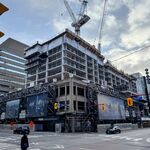B
billonlogan
Guest
Suburban air no better, study finds
Perception wrong
April Lindgren
CanWest News Service
Wednesday, June 07, 2006
Suburbanites in places like Markham, Oshawa, Caledon and Burlington believe the air they breathe is cleaner than that of downtown Toronto, but they are just plain wrong, concludes a new study.
"The bottom line is that people do not understand that their air quality is equally bad on smog alert days everywhere in the Greater Toronto Area," concluded Eva Ligeti, executive director of the Clean Air Partnership. "You have to get very far away from the GTA for air quality to improve."
The partnership, a charitable organization that promotes improvements in local air quality, commissioned a telephone survey that found the majority of residents contacted in Oshawa (56%), Burlington (60%), Caledon (66%) and Markham (69%) think their air quality is better than that in downtown Toronto.
The reality, however, is that last year there were 48 smog alert days in each and every community surveyed, as well as is downtown Toronto, Ms. Ligeti noted.
Air-quality samples taken as part of the study confirmed the bad news for suburbanites.
The concentration of particle pollutants that trigger smog alerts was the same in all the samples, concluded University of Toronto researcher Greg Evans. The microscopic particles are generated by auto emissions and by coal-fired power plants in Ontario and the northeastern United States.
"When winds are light southwesterly and the weather conditions are static, smog spreads like a flooding river over the whole region causing major increases in adverse health effects," warned Dr. David Pengelly, a member of McMaster University's Institute of Environment and Health.
Last summer, Ontarians in the GTA would have had to travel north of Parry Sound and as far east as Kingston if they wanted significantly fewer smog alert days. Even then, Sudbury had 20 smog alerts days, Sault Ste. Marie 10 and the Ottawa area 25.
Mr. Evans's research did show that when it comes to ultra-fine particles emitted exclusively by autos, local residents do have some ability to control what goes into their lungs. "The concentrations of ultrafines vary dramatically depending on how close you are to a major roadway," he said.
The poll also found that 73% of respondents, all of whom live outside Toronto's downtown, rated the general air quality in the centre of the city as poor. At the same time, 58% believed the air quality in their own suburban neighbourhood was good.
The survey of 452 people was done in late May and has a margin of error of 4.6% 19 times out of 20.
---------------------------------------------------------
I always laugh at those people who say the air is alot fresher and cleaner outside downtown Toronto. Most smog alerts blanket southern Ontario. I find highways or heavy traffic roads the worst. I usually keep my windows closed most of the time when driving.
Perception wrong
April Lindgren
CanWest News Service
Wednesday, June 07, 2006
Suburbanites in places like Markham, Oshawa, Caledon and Burlington believe the air they breathe is cleaner than that of downtown Toronto, but they are just plain wrong, concludes a new study.
"The bottom line is that people do not understand that their air quality is equally bad on smog alert days everywhere in the Greater Toronto Area," concluded Eva Ligeti, executive director of the Clean Air Partnership. "You have to get very far away from the GTA for air quality to improve."
The partnership, a charitable organization that promotes improvements in local air quality, commissioned a telephone survey that found the majority of residents contacted in Oshawa (56%), Burlington (60%), Caledon (66%) and Markham (69%) think their air quality is better than that in downtown Toronto.
The reality, however, is that last year there were 48 smog alert days in each and every community surveyed, as well as is downtown Toronto, Ms. Ligeti noted.
Air-quality samples taken as part of the study confirmed the bad news for suburbanites.
The concentration of particle pollutants that trigger smog alerts was the same in all the samples, concluded University of Toronto researcher Greg Evans. The microscopic particles are generated by auto emissions and by coal-fired power plants in Ontario and the northeastern United States.
"When winds are light southwesterly and the weather conditions are static, smog spreads like a flooding river over the whole region causing major increases in adverse health effects," warned Dr. David Pengelly, a member of McMaster University's Institute of Environment and Health.
Last summer, Ontarians in the GTA would have had to travel north of Parry Sound and as far east as Kingston if they wanted significantly fewer smog alert days. Even then, Sudbury had 20 smog alerts days, Sault Ste. Marie 10 and the Ottawa area 25.
Mr. Evans's research did show that when it comes to ultra-fine particles emitted exclusively by autos, local residents do have some ability to control what goes into their lungs. "The concentrations of ultrafines vary dramatically depending on how close you are to a major roadway," he said.
The poll also found that 73% of respondents, all of whom live outside Toronto's downtown, rated the general air quality in the centre of the city as poor. At the same time, 58% believed the air quality in their own suburban neighbourhood was good.
The survey of 452 people was done in late May and has a margin of error of 4.6% 19 times out of 20.
---------------------------------------------------------
I always laugh at those people who say the air is alot fresher and cleaner outside downtown Toronto. Most smog alerts blanket southern Ontario. I find highways or heavy traffic roads the worst. I usually keep my windows closed most of the time when driving.




